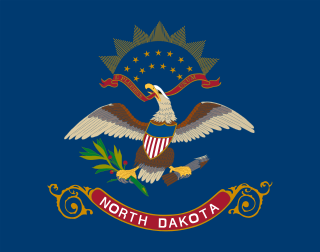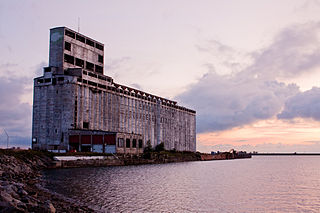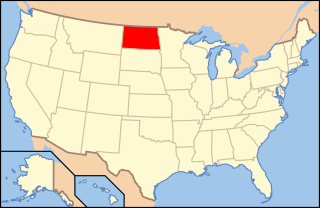
Minnesota is a state in the upper Midwestern United States. It is the 12th largest U.S. state in area and the 22nd most populous, with over 5.7 million residents. Minnesota's geography consists of western prairies, now given over to intensive agriculture; deciduous forests in the southeast, now partially cleared, farmed, and settled; and the less populated North Woods, used for mining, forestry, and recreation. Roughly a third of the state is covered in forests, and it is known as the "Land of 10,000 Lakes" for having over 14,000 bodies of fresh water of at least ten acres. A little more than half of Minnesotans live in the Minneapolis–Saint Paul metropolitan area, known as the "Twin Cities", the state's main political, economic, and cultural hub. The Twin Cities is the 16th largest metropolitan area in the U.S. Other Minnesota minor metropolitan and micropolitan statistical areas include Duluth, Mankato, Moorhead, Rochester, and St. Cloud.

North Dakota is a U.S. state in the upper Midwest of the country. It is named after the indigenous Lakota and Dakota Sioux, who historically dominated the territory and remain a large community. North Dakota is bordered by the Canadian provinces of Saskatchewan and Manitoba to the north and by the U.S. states of Minnesota to the east, South Dakota to the south, and Montana to the west. It is believed to host the geographic center of North America, situated in the town of Rugby, and is home to the tallest man-made structure in the Western Hemisphere, the KVLY-TV mast.

A grain elevator is an agrarian facility complex designed to stockpile or store grain. In the grain trade, the term "grain elevator" also describes a tower containing a bucket elevator or a pneumatic conveyor, which scoops up grain from a lower level and deposits it in a silo or other storage facility.

The Nonpartisan League (NPL) was a left-wing political party founded in 1915 in North Dakota by Arthur C. Townley, a former organizer for the Socialist Party of America. On behalf of small farmers and merchants, the Nonpartisan League advocated state control of mills, grain elevators, banks and other farm-related industries in order to reduce the power of corporate and political interests from Minneapolis and Chicago.

Cream of Wheat is an American brand of farina, a type of breakfast porridge mix made from wheat middlings. It looks similar to grits, but is smoother in texture since it is made with ground wheat kernels instead of ground corn. It was first manufactured in the United States in 1893 by wheat millers in Grand Forks, North Dakota. The product made its debut at the 1893 World's Columbian Exposition in Chicago, Illinois. Before January 2007, Cream of Wheat was a Nabisco brand made by Kraft Foods. In January 2007, B&G Foods acquired the brand and all rights to market the cereal. "Cream of Wheat" is a registered trademark.
The North Dakota Democratic–Nonpartisan League Party is the North Dakota affiliate of the Democratic Party. It was formed as the outcome of a merger of two parties; the state previously had a three-party political system. It is one of only two state Democratic Party affiliates to have a different name, the other being the neighboring Minnesota Democratic–Farmer–Labor Party.

The 1921 North Dakota gubernatorial recall election was a recall election of North Dakota Governor Lynn Frazier in 1921. Frazier was the first U.S. governor ever successfully recalled from office; there would not be another successful recall of a governor until California Governor Gray Davis was recalled in 2003.
Arthur Charles Townley was an American political organizer best known as the founder the National Non-Partisan League (NPL), a radical farmers' organization which had considerable political success in the states of North Dakota and Minnesota during the second half of the 1910s.

North Dakota was first settled by Native Americans several thousand years ago. The first Europeans explored the area in the 18th century establishing some limited trade with the natives.

John Miller was a bonanza farmer, business man and American Republican politician in North Dakota. He served as the first Governor of North Dakota from 1889 to 1891, after it was admitted as a state to the union.

Arthur Gustave Sorlie was an American businessman and politician who served as the 14th Governor of North Dakota from 1925 until his death in 1928 at the age of 54.

Charles Alfred Pillsbury was an American businessman, flour industrialist, and politician. He was a co-founder of the Pillsbury Company.

Minneapolis is the largest city by population in the U.S. state of Minnesota, and the county seat of Hennepin County. The origin and growth of the city was spurred by the proximity of Fort Snelling, the first major United States military presence in the area, and by its location on Saint Anthony Falls, which provided power for sawmills and flour mills.
Arrowhead Mills is a brand of organic baking mixes, grains, cereals, and nut butters.
Richardson International Limited is a privately held Canadian agricultural and food industry company headquartered in Winnipeg, Manitoba. The company is one of several companies that are owned by James Richardson & Sons Limited. The company is a worldwide handler and merchandiser of all major Canadian-grown grains and oilseeds and a vertically-integrated processor and manufacturer of oats and canola-based products. Richardson has over 2,500 employees across Canada, the U.S. and U.K. Richardson International is a subsidiary of James Richardson & Sons, Limited, established in 1857.

Mill City Museum is a Minnesota Historical Society museum in Minneapolis. It opened in 2003 built in the ruins of the Washburn "A" Mill next to Mill Ruins Park on the banks of the Mississippi River. The museum focuses on the founding and growth of Minneapolis, especially flour milling and the other industries that used hydropower from Saint Anthony Falls.
William A. Anderson was a politician and judge who served as the 30th mayor of Minneapolis.

The Socialist Party of North Dakota was the semi-autonomous affiliate of the Socialist Party of America established in 1902 in the state of North Dakota. The organization had roots in a socialist club founded by Norwegian immigrants in Fargo in 1900. One of the party's professional organizers, a former farmer named Arthur C. Townley, abandoned the group in 1915 to establish a new organization called the Non-Partisan League. The rapid growth of this organization spelled the demise of the official Socialist organization in the state.
Wheat is produced in almost every state in the United States, and is the principal cereal grain grown in the country. The type and quantity vary between regions. The US is ranked third in production volume of wheat, with almost 58 million tons produced in the 2012–2013 growing season, behind only China and India. The US is ranked first in crop export volume; almost 50% of its total wheat production is exported.

















